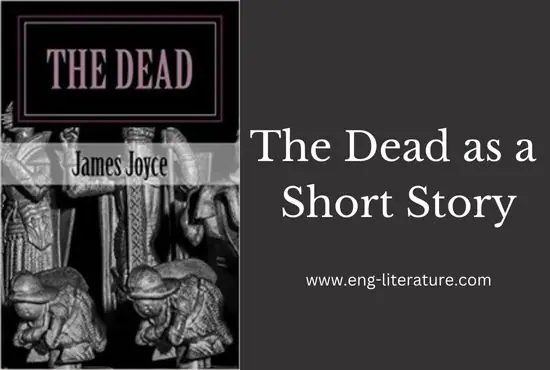The Dead as a Modern Short Story
By general consensus, The Dead is the greatest of all the stories in Dubliners-the longest, richest, and most emotionally affecting-and the story more than any other that points toward Joyce’s career as one of the English language’s greatest novelists ever. The story reiterates the great themes of Dubliners. Gabriel’s marriage is clearly suffering from paralysis, the condition of nearly all the characters in the collection. This accounts for his excitement at story’s end when he believes that Gretta’s passion relates to him and them, as their marriage has decayed badly over the years. In this story, paralysis is represented as usual by the colors yellow and brown, but Joyce also employs the symbolism of snow and ice; after all, if something is frozen, it is motionless-paralyzed.
Point of view is the perspective from which the writer tells the story.”The Dead” is told in the third person limited point of view. Although the narrator describes the action of many of the characters and even depicts some events Gabriel does not witness, only Gabriel’s thoughts are given. Joyce’s writing style is also relevant when discussing point of view. Joyce was one of the first writers to practice the mimetic style. Mimetic style a style that mimics or imitates – does not report thoughts using objective language but shows the character’s thoughts by using the character’s language.
Also Read:
In “The Dead,” the first sentence is an example of mimetic style: “Lily, the caretaker’s daughter, was literally run off her feet.” The last phrase of that sentence, “literally run off her feet,” is actually mimicking what Lily would say. Another example is when Gabriel looks over his speech and is worried that he “would fail with them just as he had failed with the girl in the pantry.” The phrase is more akin to Gabriel’s dialogue than to the words of an objective narrator, and it shows his frustration over his earlier encounter with Lily. This device has become common in fiction, but Joyce was one of the first to use it.
“The Dead” can be categorized with stories that are in the realist tradition. A realistic writer will simply try to present life as it is without making a sensational plot or interpreting events. A reader might say that nothing eventful really happens, as is so often the case in real life. In “The Dead” Joyce, for the most part, shows but does not tell. He simply presents the characters’ thoughts and actions without comment. Even at the end, when Gabriel has his revelation, the reader is left not knowing exactly what his revelation means. Presentation without comment forces the reader to interpret the events for him- or herself. Setting is simply when and where the action of the story happens. As with the rest of Dubliners, “The Dead” is set in Dublin, Ireland, in the early twentieth century. Joyce said that he wanted to write “a chapter in the moral history” of his country and that Dublin seemed the appropriate place because it seemed to him the center of paralysis. The action takes place in two specific places: at Kate, Julia, and Mary Jane’s house in Usher Island, which is an actual section of Dublin, and at the Gresham, a fashionable hotel in Dublin. Critics conclude that it takes place on January 5th, which is the eve of Epiphany.
Epiphany is from a Greek word meaning manifestation. Christianity celebrates the feast of Epiphany on January 6, honoring the manifestation of the baby Jesus to the wise men from the East, and the term generally refers to the manifestation of God’s presence in the world. Joyce, however, made the word into a literary term. He described it as a spiritual manifestation that reveals the true essence of an object or character, and he used it as the climax of many of his stories.
In “The Dead” Gabriel has such a spiritual manifestation after Gretta tells him about Michael Furey, in the early morning hours of Epiphany. A symbol is an object, person, or place that stands for something else, usually an abstract idea. For example, critics have said that Mr. Browne is a symbol for British rule in Ireland. The most debated symbol in “The Dead” is the snow which covers “all the living and the dead.” Critics disagree over whether it stands for Gabriel’s new ability to transcend his own self-absorption or whether it is a symbol of the paralysis that he still has and cannot overcome.

Hello, Viewers! Besides being the Founder and Owner of this website, I am a Government Officer. As a hardcore literary lover, I am pursuing my dream by writing notes and articles related to Literature. Drop me a line anytime, whether it’s about any queries or demands or just to share your well-being. I’d love to hear from you. Thanks for stopping by!
